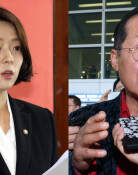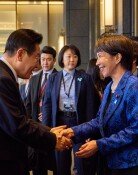Planned Merger to Create City Bigger Than Seoul
Planned Merger to Create City Bigger Than Seoul
Posted January. 23, 2010 09:00,
The planned merger of the Seoul suburbs of Seongnam, Gwangju and Hanam will spawn a giant city tentatively called Seonggwangha.
The Seongnam City Council approved the merger yesterday. Ostensibly, the new entity will be technically classified as a city, but will be larger in size than Seoul. The new citys mayor will have an administrative power and structure comparable to that of a provincial governor thanks to the central governments plan to grant incentives for a merger.
Seonggwangha will likely receive ample assistance when implementing diverse projects. Pending issues in the region will be resolved, and the increased administrative power of the merged city will allow speedier administrative services.
The three cities originally used to belong to the same administrative district, and hence no cause for emotional conflict among residents is expected. Given protests by opposition parties with the merger process, however, a bumpy road lies ahead for the merger.
The central government will provide the merged city with 60 percent more tax revenue granted to autonomous administrative districts for 10 years. Fiscal assistance to the merged city through this measure alone will amount to 642.9 billion won (557.8 million U.S. dollars).
To prevent the degradation of administrative services resulting from the merger, up to five new ward offices will be established. The mayor will have the right to give permit construction of buildings of up to 50 stories high and the issuance of regional development bonds.
When the cities are merged, their budget will reach 3.2 trillion won (2.8 billion dollars), topping that of Gwangju with 2.71 trillion won (2.3 billion dollars), Ulsan with three trillion won (2.6 billion dollars), and Daejeon with 2.68 trillion won (2.3 billion dollars). Thus, Seonggwangha will effectively grow to the size of a metropolitan city.
The Public Administration and Security Ministry will also grant preference when the central government designates boarding, meister and self-regulated private high schools as promised to help the districts development. This measure is designed to promote an administrative district reshuffle.
The central government will also grant preferential treatment to the merged city when it builds a museum, gallery, gymnasium, library and sports facilities.
As a result, the government will likely accept to a certain degree Seongnams demand to raise the permissible height of buildings when its residents in older towns build or expand buildings. The central government will also likely accept Hanams request to ease development-restricted areas, or green belts, which account for 85 percent of territory when the merged city is inaugurated.
Amid resistance by opposition parties, Seongnam City Council Chairman Kim Dae-jin accepted a suggestion to change the plenary schedule made by council members of the ruling Grand National Party. He submitted the bill for deliberation at his own discretion.
When Kim asked the council members whether they agree, ruling party members of the council shouted agreed in unison.
Members of opposition parties objected and made an appeal. Kim declared the approval of the merger plan, however, and dismissed the meeting.
I wanted to proceed with the council meeting in a normal fashion but it was impossible to do so, Kim said. Since we processed the bill according to rules, there will be no problem. But I regret it was not done as smoothly as the public hoped.
Certain residents of the three cities to be merged remained strongly opposed to the merger. Cho Sang-jeong, co-chairman of a civil committee to block the merger, said, Council members of the Grand National Party had the bill approved in an unfair way without making an excuse, adding, When the committee conducted a recent opinion poll of more than 2,000 residents, half of them objected.
The committee said it will team up with other civic groups to stage a campaign to block the reelection of council members with the ruling party.




![[속보]美 “미국인은 이란 당장 떠나라” 대사관 긴급 공지](https://dimg.donga.com/c/138/175/90/1/wps/NEWS/IMAGE/2026/01/13/133147285.1.jpg)


